Tofu mofu bofu is not a vegetarian dish, but rather a key ingredient 🔑 in the recipe for a well-seasoned strategy.
Composed of different stages (Top, Middle and Bottom), this strategy will enable you to capture your prospects’ attention, support them and, above all, convert them into loyal customers. 🫱🏽🫲🏼
How do you concoct this recipe without wasting too much time? That’s what we’re going to find out here!
Grab your best chef’s hat and let’s get started! 🧑🏼🍳 (Reading time: approx. 4 minutes)
What is tofu mofu bofu?
Well, as I was saying, we’re not talking about a new culinary trend here, but rather a digital marketing method.
These three acronyms simply stand for the main stages of a marketing funnel (a strategy used to guide prospects from brand discovery through to conversion into customers). 💪🏼
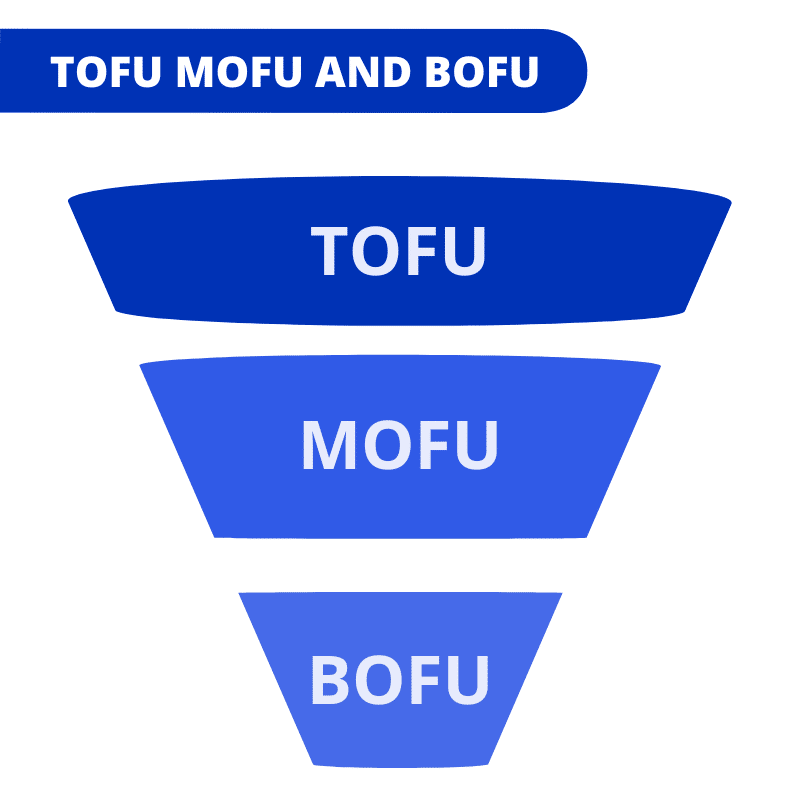
Here’s a quick explanation:
- 1️⃣ TOFU (Top of the Funnel) ⭢ first stage, the aim is to capture the attention of a broad audience.
- 2️⃣ MOFU (Middle of the Funnel) ⭢ intermediate stage aims to deepen the relationship with prospects by providing concrete solutions.
- 3️⃣ BOFU (Bottom of the Funnel) ⭢ final stage aims to convince prospects ready for purchase with solid arguments.
Now that I’ve made your mouth water (very food-oriented this article therefore says 😅), let’s discover each of these parts in more detail. 👀
Tofu: the top of your funnel
The Top of the Funnel represents the pinnacle of the marketing funnel, i.e. the very first stage where the aim is to make your brand known and attract a large audience. 🧲
At this stage, your prospects don’t know you yet, and they may not even be aware of their own needs or problem.
That’s why, your mission, is to attract as many qualified visitors as possible to your content or website. We’re not asking you to sell, but to create an initial connection. 🩵
And to get there, here are 3 golden rules to follow:
- Inform ➡️ Help your prospects identify a problem they’re facing.
- Educate ➡️ Offer resources that provide answers (or at least knowledge).
- Captivate ➡️ Spark interest by answering their questions or arousing their curiosity.
Okay, but what content would you say? 👀
Well, here are a few examples:
- 📝 Blog posts.
- 🎨 Infographics.
- 🎥 Short videos.
- 💬 Posts on LinkedIn.
- 📖 White papers.
- 🛜 E-books.
- 🖥️ Free webinars.
These contents are thought for a wide audience, often found via Google searches or social networks. 🛜
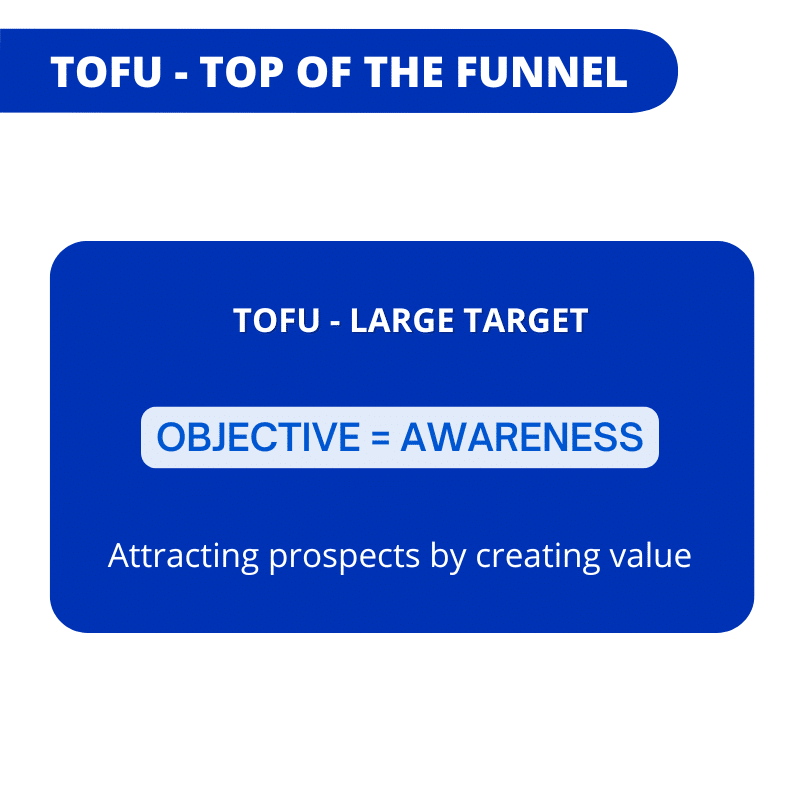
Okay, but where can I distribute my content? 🤔
It’s simple, choose the platforms where your target audience spends the most time. Don’t know? Okay, overall it’s :
- 🔷 Social networks: LinkedIn, Facebook, Instagram or TikTok, depending on your audience.
- 🔷 Native advertising: sponsored posts.
- 🔷 Emailing: general campaigns to reach existing subscriber lists.
And if you want to know if your strategy is working, track the following KPIs: 👇🏼
- Impressions ⭢ number of times your content has been viewed.
- Engagement ⭢ likes, shares and comments on your posts.
- Click-through rate (CTR ) ⭢ on your ads or sponsored content.
- Time spent on your pages ⭢ measure of interest in your content.
Example of a tofu strategy
Now that you’re a little more familiar with tofu 🌿, we wanted to show you an example of a tofu strategy with a little analysis (I promise, it’s quick). 🔎
To illustrate our point, we’ve chosen to analyze the post of our Global HR Director, Violette Léger.
Her objective here is to improve brand awareness and reinforce the company’s image with potential candidates.
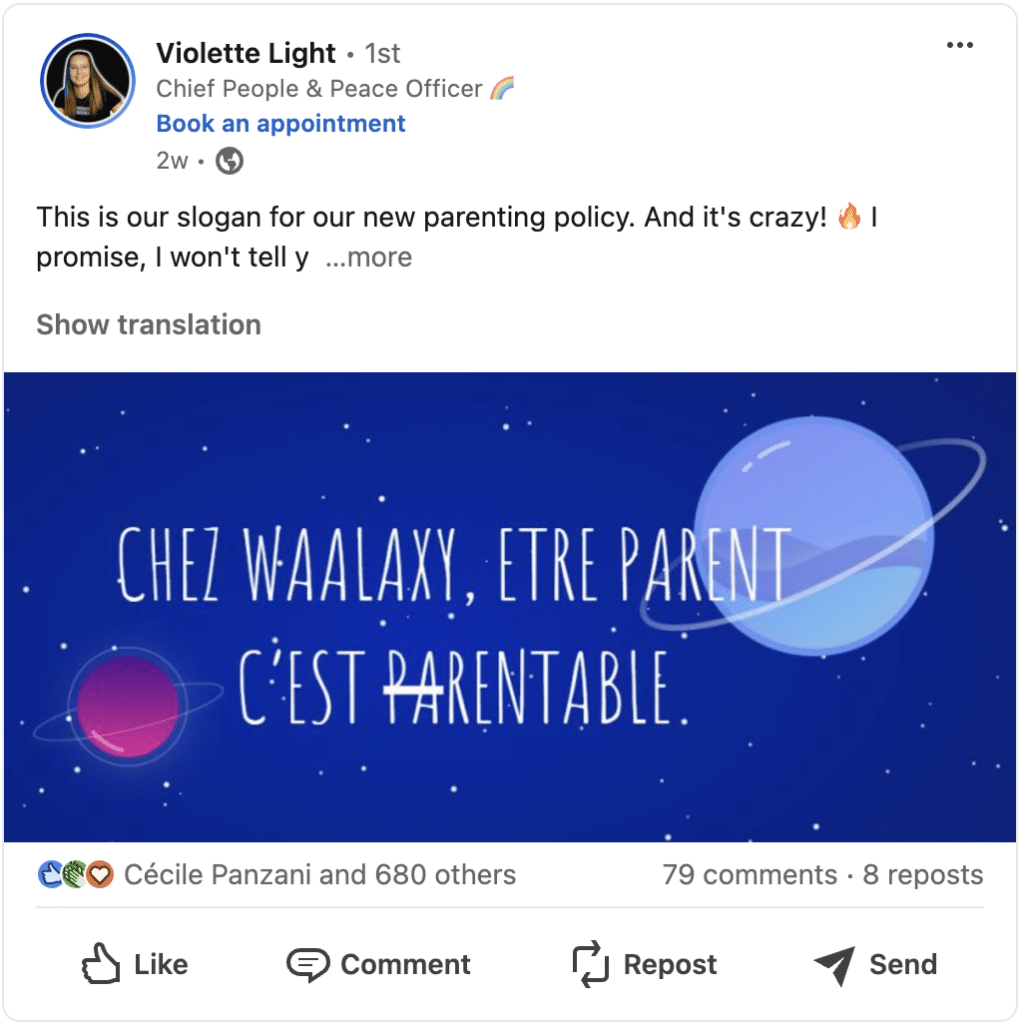
In this post, she presents the company’s new slogan:
“At Waalaxy, parenting is
parentable“.What does this slogan mean to you? Personally, I think it seeks to arouse curiosity and start a conversation around the content. 🦋
💡The aim is to raise awareness among a wide audience and generate interest in the brand.
This type of informative and engaging content is typical of a TOFU approach, where the focus is on initial awareness and engagement, rather than direct promotion of products or services. 👀In doing so, Violette creates an initial connection with potential prospects, informing them of brand developments. 📈
Now that the foundations have been laid, we can move on to the next interactions. 😈
Mofu: the middle of your funnel
Now we come to the second and penultimate stage of the tofu mofu bofu, I call it the Middle of the Funnel (MOFU)! 🥁
Here, your prospects begin to seriously evaluate their options, let me explain. 👇🏼
If TOFU was about 🏹 getting their attention, here we’ll be looking to build relationships by addressing their needs.
This is where you walk your prospects through their thinking and start to propose your offer as a solution to their needs.
Your mission here (if you accept it) is to accompany your qualified leads to help them better understand their needs and solutions.
Roughly speaking, they know they have a problem to solve, but they’re still considering their options and haven’t made a decision.
And that’s where you come in 🫵🏼 (without being too intrusive or aggressive, of course).
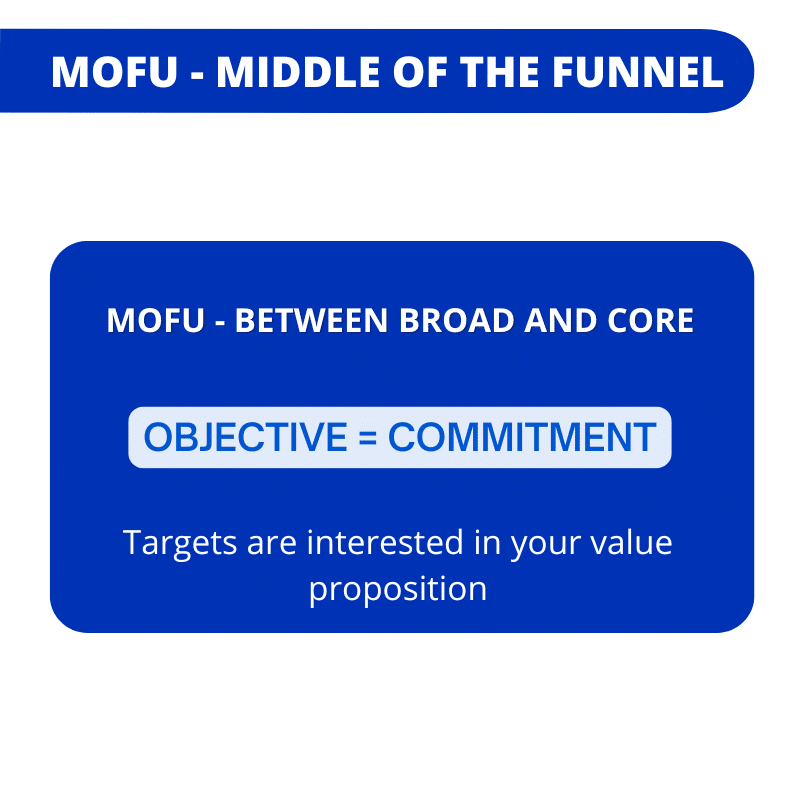
In fact, you need to show that you understand their needs, with a few formats such as :
- Case studies: show how other customers have solved similar problems using your solutions.
- Detailed how-to guides: provide clear information on how to solve a specific problem.
- Webinars: offer live interaction to answer their questions.
- Comparatives: help your prospects compare different possible choices (take the opportunity to add your own).
- Nurturing emails: send personalized email sequences to keep in touch.
Now, if you’re doing all that, you’re doing great! 🤩
Okay, but where do you distribute these formats? 👀
It’s important not to rush and to choose your distribution channels carefully. Here are our recommendations:
- 📧 Emailing campaign ➔ automated sequences to send tailored information.
- 🖥️ Dedicated landing pages ➔ optimized pages to host your guides or webinars.
- 🛜 Social networks ➔ sharing case studies or webinar announcements via publications.
- 🎯 Targeted advertising ➔ use of retargeting for visitors who have interacted with your TOFU content.
To find out whether your strategy is working, consider keeping a close eye on the following indicators:
- 🔹 Number of qualified leads generated.
- 🔹 Rate of participation in your webinars.
- 🔹 Number of downloads of your guides.
- 🔹 Open and click rates on your e-mails.
Mofu strategy example
As usual, we’re going to break down 🍤 an example of a mofu strategy, just for your viewing pleasure.
Here, the audience is more qualified. Violette’s aim here is to promote the company’s values, career opportunities and benefits, and even to offer advice and position herself as a recruitment expert.
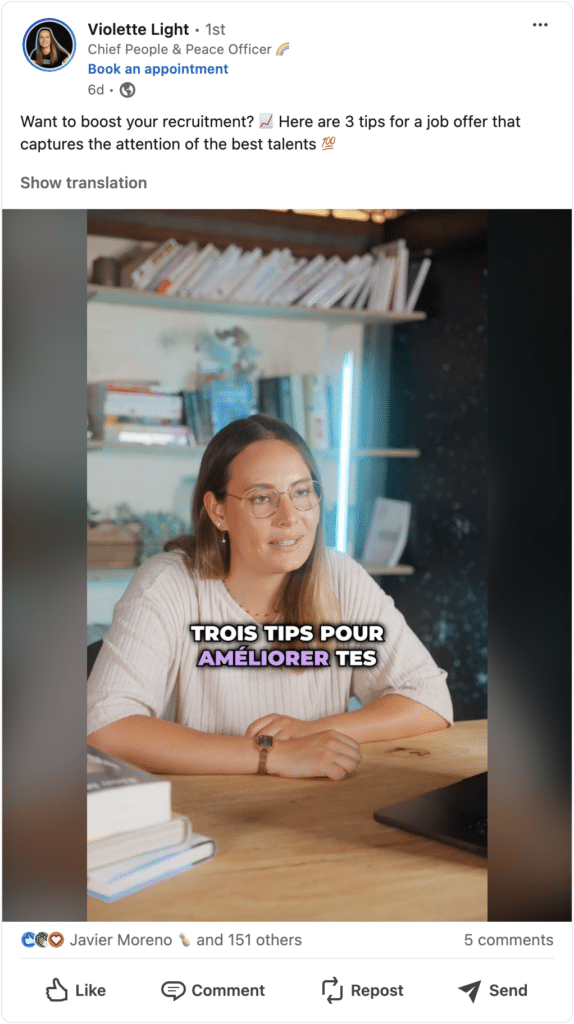
As you can see, this post speaks directly to recruiters with an engaging question: “Want to boost your recruiting? Here’s how Waalaxy can help”.
This choice of tone and wording is well chosen, as it immediately grabs the attention of a targeted audience (aka professionals looking for a way to optimize their recruitment processes).
Basically, the post focuses on a precise need and proposes Waalaxy, a prospecting and automation tool on LinkedIn and Inmails.
It’s not just a tool presentation, but a demonstration of its added value.
By highlighting the concrete benefits of the tool, Violette seeks to establish a bond of trust with her audience by proving that Waalaxy is the most reliable solution. 🥇
Bofu: the bottom of your funnel
Now we come to the final stage of this recipe, the Bottom of the Funnel (BOFU). This is where your prospects are well informed and ready to make a buying decision.
In fact, after grabbing their attention at the TOFU, cultivating their interest at the MOFU, this is where you directly encourage them to take action (aka, to buy 💶).
More precisely, the aim here is to turn interest into conversion. This could be a purchase, a subscription or some other final commitment.
The approach needs to be direct, you need to show that your offer is the best option.
To help you, we’ve put together a short list of the most important things to remember: ⬇️
- Clear value proposition: show how your product exactly meets the prospect’s needs.
- Demonstrations: the prospect can visualize the value of your offer in concrete terms.
- Free trials: offer to test your solution.
- Special or urgent offers: time-limited promotions can create a sense of urgency.
- Reviews and testimonials : positive feedback from other customers reinforces credibility.
- Advanced webinars: offer small meetings to answer questions live.
Interesting, but where to broadcast it? 👀
Well, here are some interesting channels:
- 📧 Personalized follow-up emails.
- 🖥️ Dedicated landing pages.
- 📞 Calls or consultations.
- 💬 Remarketing ads.
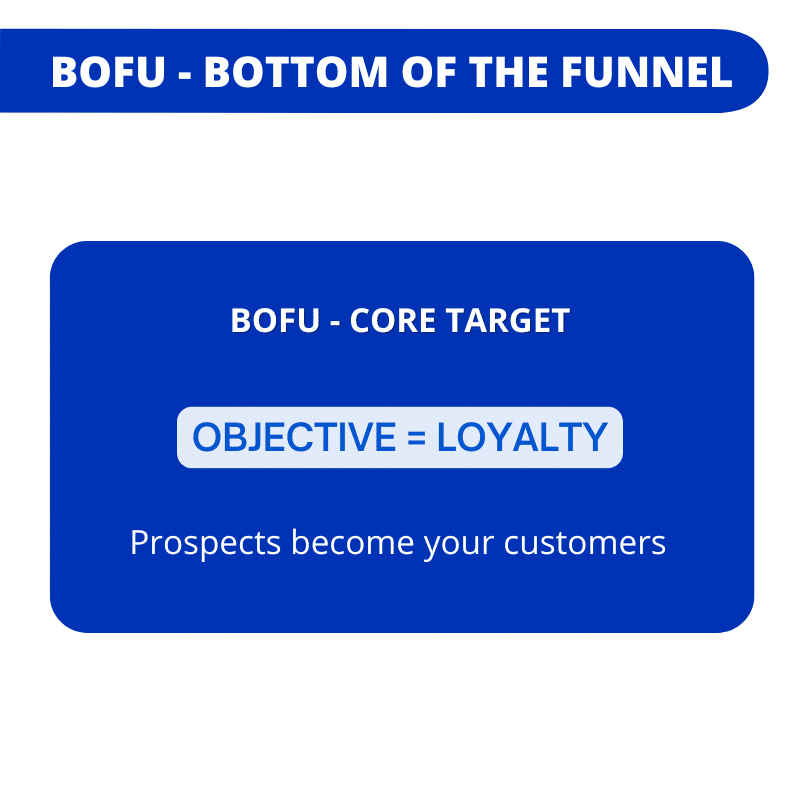
Perfect, now, as usual, here are some performance indicators to track:
- 🔹Conversion rates.
- 🔹 Average order value (ACV).
- 🔹 Return on investment (ROI).
Example of a bofu strategy
For the BOFU strategy, what better than a recruitment post to end on a high note? ✨
Now that Violette has educated her prospects about employer branding, benefits, company policy, it’s now time for her to take action and share recruitment offers.
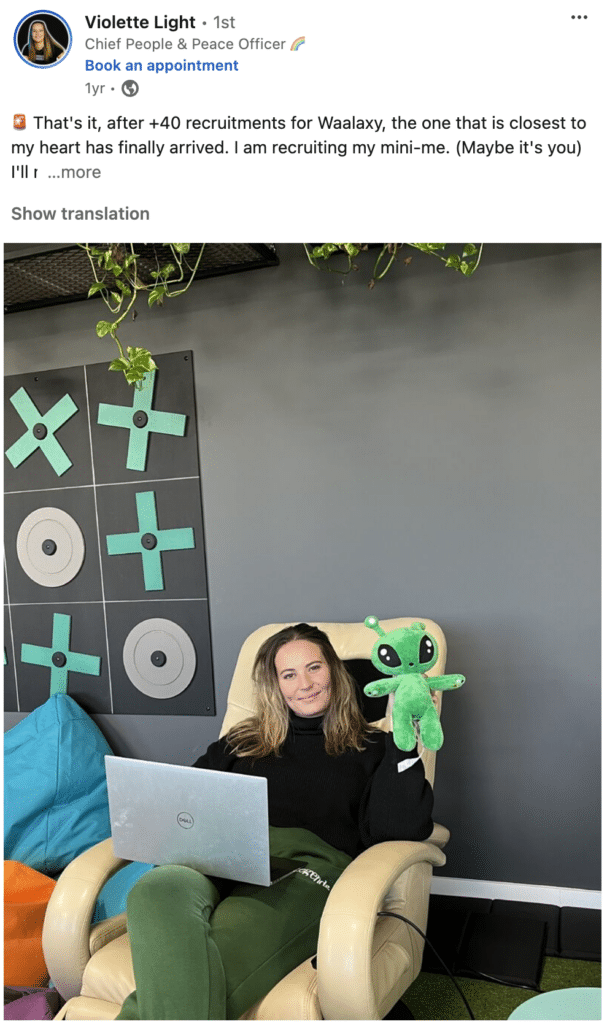
First, she puts up a photo of herself with an alien, Waalaxy’s emblem, to make the recruitment offer less formal.
Then, in her post, she explains that she’s looking for her “mini-me”, in other words, a person who will accompany and support her to help with her recruitment missions. 👀
How to automate your tofu mofu bofu strategy on LinkedIn?
Automating your tofu mofu bofu strategy on LinkedIn can completely change the way you generate leads and convert them. 👀
With over a billion users, this social network is a real professional 🍪 goldmine and will enable you to reach your target audience at every level.
However, we wouldn’t recommend manually managing 👋🏽 every interaction, as this is very, very time-consuming. ⏱️
This is exactly where automation tools come in! 🚪
And today, we’re going to introduce you to Waalaxy, which comes to us straight from Montpellier. 👽
Hang on, we’re giving you 3 tips to boost your strategy! 🚀
1) Attract new leads
First of all, we want leads to come to us. There are several ways of doing this (we recommend you do them all at the same time). 👇🏼
1️⃣ Optimize your LinkedIn profile.
Before looking to attract leads, make sure your profile is professional. Showcase your skills, services and value proposition, not to mention a snazzy banner!
2️⃣ Identify your target audience.
Use LinkedIn’s advanced search filters to find profiles that match your criteria (position, sector, location). For example, target B2B marketers if your offer allows.
3️⃣ Create engaging content.
Publish regular posts that provide value. To do this, share practical tips, trends and even case studies.
4️⃣ Send personalized invitations.
When searching, feel free to send connection requests with a personalized message. 💬
Waalaxy lets you set up campaigns to send connection requests and welcome messages on a large scale, without neglecting personalization. 🛸
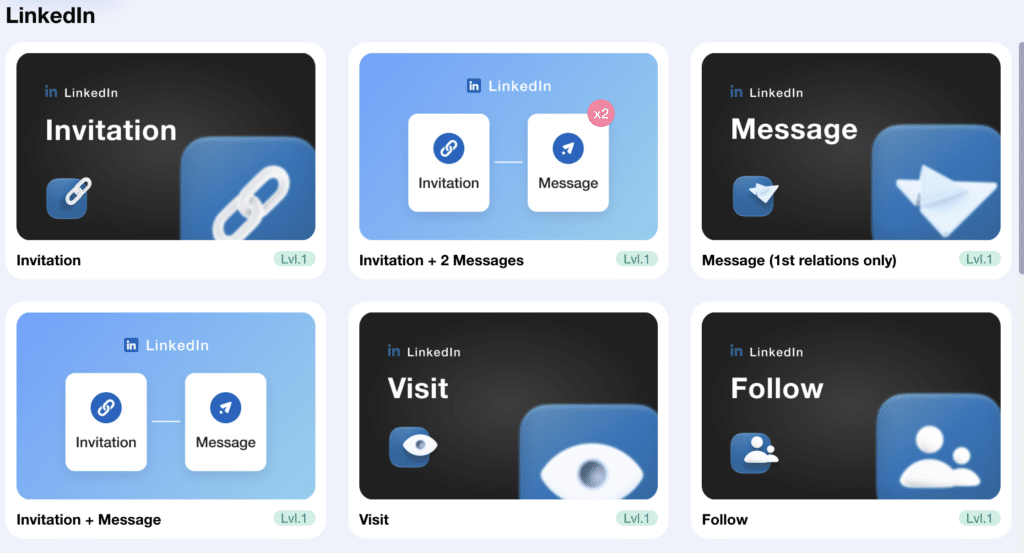
2) Support your leads
Once you’ve added your leads to your LinkedIn network, you now need to accompany them in their choices and get them to think about your offer. 👀
Here’s an example to help you understand. 👇🏼
After a connection, program an initial thank-you message followed by a link to your best e-book 📚 that addresses one of their issues.
Also, invite your prospects to participate in events like webinars or online workshops.
This interactive format gives them a deeper understanding of your product while strengthening your bond.
The invitation could be called “How to double your leads in 30 days with automation on LinkedIn”, for example. 😇
And finally, always have a follow-up on your campaigns! 👀
3) Finalize conversions
Last but not least, you need to finalize your conversion, i.e. turn your qualified leads into customers.
On LinkedIn, that means adopting a direct, targeted approach.
To do this, you can set up follow-up campaigns that send reminders to the most advanced leads.
I’m thinking in particular of a free demo or limited trial of your product, which allows the prospect to project themselves and concretely test your solution! 😇
Here’s an example of a message to personalize:
“Hello {{FirstName}}, I see you’ve checked out our LinkedIn automation resources. To take it a step further, we offer a free Waalaxy demo tailored to your needs. It will show you how to double your leads by automating your campaigns. Would you be available this week for a quick 15-minute session?”
But that’s not all, share your customer testimonials and case studies, which will directly reinforce the credibility of your offer. 💪🏼
How about a recap?
As you can see, automating your tofu mofu bofu strategy is much more than just a time-saver; it’s a smart, strategic way of transforming your online presence into a real engine of growth. 🛞
With the right tools, like those on LinkedIn, you’ll be able to both, multiply your interactions, and make them impactful. 💥
Frequently asked questions
Wait, don’t go away so quickly, find out the most frequently asked questions on the subject! 👇🏼
What are the 3 stages of the conversion funnel?
The conversion funnel is made up of three key stages 🔑 :
- 1️⃣ Top of the funnel: attracting the attention of a large audience.
- 2️⃣ Middle of the funnel: prospects evaluate different solutions.
- 3️⃣ Bottom of the funnel: prospects are ready to make a purchasing decision.
Each of these stages is important, so don’t neglect them! 👀
What types of conversion are there?
For conversions, you can use the AIDA method. Here’s what it’s all about. ⬇️
| AIDA step | Description | Conversion goal |
|---|---|---|
| Attention | Capture the prospect’s attention with hard-hitting messages or attractive visuals. | Visit a web page, click on an ad, engage on a post. |
| Interest | Generate interest by highlighting benefits or solutions adapted to the prospect’s needs. | Newsletter subscription, ebook consultation, time spent on site. |
| Desire | Awaken desire by reinforcing the perceived value of the offer, overcoming objections and building trust. | Add to basket, request a demo, consult a case study. |
| Action | Incite a concrete, measurable action that marks the final conversion. | Purchase, subscription, make an appointment. |
You’re now a whiz at the tofu mofu bofu strategy. See you soon! 👋🏽









